|
EXU

Is an Orixá of multiple and contradictory aspects, which makes it hard to describe him in a coherent manner. Exu is the guardian of temples, homes, cities and people. He’s also the intermediary between gods and men. For this reason nothing is done without him. Offerings are first done to them, before any other Orixá, to neutralize their tendencies to provoke misunderstandings within human beings, their relations with their gods and even within gods themselves.
The Archetype of Exu is very common in our society, where people with ambivalent character proliferate, both good and bad at the same time.
Salutes – Laroi and Exu or Bara o
Salutes
– Laroi and Exu or Bara o
|
|
|
OGUM
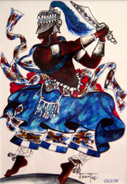
Represents the force of Justice and war. He is patron of the soldier warrior, of hunters, of people who pursue their objectives energetically and are not easily drawn away. He protects the iron workers, the makers of tools, associating himself with hard labor. Symbolically he is the Orixá of universe’s evolution with its dynamics heading for the infinite.
The sons of Ogum, have a working-oriented behavior, are helpful and tend to focus on physical work almost always manually. Therefore, they’re generally skillful.
Salutes
– Patakori, Jaci ,Jaci , or even Ogum, Ogunhe!
|
|
|
OXÓSSI
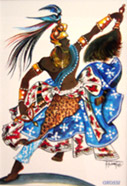
God of Hunters, represents the control over the forests, makes your expeditions successful, resulting in abundant game. He is designated “ODÊ”, his original name is related to the genesis of the world and the constitution of the planet Earth. His dance represents the movements in the hunting, movements of the bow and arrow, about to shoot. There are moments where a dispute with Ogum for the mythical hierarchy is demonstrated. The sons of Oxossi are smart, quick, rápidas, always alert and moving. They demonstrate an intellectual agitation; they are metaphysical, dreamers, creative and unstable. They search for truths not always obtaining them due to their agitation and lack of persistence. They are full of initiative and always finding new activities and making new discoveries. They are responsible and family people. They are generous, hospitable and friends of order; but enjoy moving to new homes and finding new ways of existence sometimes in detriment of a harmonious family life and peace.
Salutes
– Okê,Odé!
|
|
|
OSSAIM
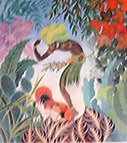
Orixá of great importance, for he is the deity of holy and medicinal plants.
Because of Iansã, the leafs of Ossaim were known throughout the world, and so every orixá tem has the property of some of these leaves, that are used for their respective rituals.
The sons of Ossaim are of balanced character, able to control their emotions and feelings. They are individual that with their extraordinaire reserve of creative energy and resistance achieve their established objectives.
Salutes
– Ewe Ewe
|
|
|
LOGUM
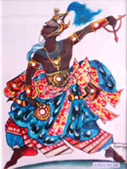
This Orixá is peculiar for he lives 6 months on the earth eating from the animals and 6 months in the sea living off fish.
He’s also a man and woman alternately in those 6 months.
This God, according to stories form Africa, has aversion to red and brown clothes.
None of his adepts dare to wear these colors.
|
|
|
OXUMARÉ
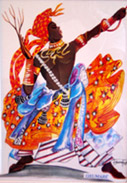
Orixá of the Rainbow, that when on earth was a great Babalawo.
The serpent that bite its own tail; symbolizes richness, continuity , that which is perpetual; It’s the connection of Heaven and Earth.
This Orixá is from the “Vodun” family (Nana ,Omolu e Obaluaê).
Salute
– Arron Bo Boi
|
|
|
OBALUAYÊ

Lord of the earth, of human existence. Always the figure of the healer.
Symbol of propagation and cure of diseases. Mythlogically wandered throughout the African tribes curing those afflicted by smallpox. One day, Obaluaye became infected with it, but thanks to his powers, he survived, although he wasn’t able to avoid disfiguration. That’s why it’s covered with Costa dry grass and its symbol is popcorn; that has a similar appearance to the skin of the afflicted. Popcorn, or, corn, is also representative of nourishment, or strengthening, or even health: Obaluaye-doctor.
The sons of Obaluaye are strict, impulsive and easily irritated; this behavior pattern is always reflected in them. They demonstrate a clear inclination to offering services for merit. They are easily found in groups of people that have great leadership skills and often heading social oriented groups for the community.
Salutes
– Atotô,Ajuberô!
|
|
|
IROCO

Was the first tree to be planted on earth and inside it lives the spirit of Iroco. A vigorous Orixá that in Brasil can have only one in initiate in every Candomble location, for there is only one gameleira (Iroco tree) in each location.
For the propria nature of this orixa, it was living in the external part of the place of fetichism, to the outdoors, to play one of its funçoes primordias that it is the linking and communication between aye(terra) and orum (sky), binds asim the elemntos land and air, and clearly it is communicated and if it integrates with the element fire in the figure of Oya. Also very on orixa oko of agriculture, Iroko is orixa of the vitality, of the vigor, passing this energy to its followers atraves of its offerings. This deity this very on the ecology and to the encantamento of the espiritos of the trees, the life of the forests and to the preservation of them. It signals to the human being that the vegetal species has its vital energy, has life… and clearly where it has life has ancestry…. A tree of Iroko in Brazil can arrive to have 250 years….Ela arrives at the future with its constant aparencia and energy, being thus one orixa that it testifies transformaçoes of the nature and the being humanso on it, being able to appeal á memory of this for the preservation of the customs which we call traditional, the rescue to the primordias forces, to the essencia of axe and the nature Representation the propria tree land Dinamica air fire: communication between the world visivel and invisivel
Colors: white accounts gusts of green or gray
Day of the week: thursday
Greeting: Ero
Salutes
Eró
|
|
|
IBEJI

The concept is that all Orixás are worshipped as holy ancestors in connection with some strength or force of nature.
The Ibeji, through syncretism called Cosme and Damião, are worshipped by the followers as holy ancestors in connection with the born twins.
|
|
|
XANGÔ

Represents lightning and thunder in all of its intensity, it’s the greatest expression of a dynasty, OYÓ, tribe found in Nigeria. He’s the greatest tribal power, retainer of judicial power, He’s choleric and imposing, owner of gold and all material richness. His symbol is the axe. The sons of Xangô are circumspect creatures, with striking attitudes and are rarely talked out of what they want by someone else. They’re made for power, especially those of economic character. They exercise little natural leadership but are great for bossing around. They keep up their judging attitudes and are quick to condemn. They are excellent magistrates, although they don’t hesitate to absolve if that’s how they see it.
Saudação-
Kao Kabiesy
|
|
|
IANSÃ
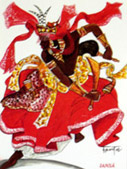
Represents the fire, the wind and storms, having control over lightning and thunder, between horizontal clouds, without reaching the soil.
She’s called OIÁ, Ruler of the dead, she’s also the warrior whose deeds were mythologically cited by Xangô. Her dance is tempestual , rowdy, agile nervous and beautiful.. The daughters of Iansã are of strong personality and make their mark in a group, always finding reasons to impose their personality. They use greatly diversified strategies for their success. They’re most notorious for activities to motivate the group. They enhance their beauty, valuing isolated personal attributes: colored clothes, haircuts, artistic manifestation, etc. Finally, they may be classified as tempestuous, subversive, mentally and physically agile. They lead but do not boss.
Salutes
Epa-Hei,Oiá!
|
|
|
OXUM
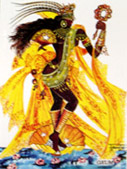
Represents the rivers, bridges and waterfalls. Is extremely feminine, of voluptuous temperament, affectionate and tender. She symbolizes the beauty of women as their fancies and seduction artifices. Her dance demonstrates these characteristics. When the individual is a female, she tends to attract the opposite sex for she carries a good dose of sensuality.
Her axés are made of stones from the bottom of the Oxum River, of copper jewels and a turtle comb.
Saudação
Ora Ie Ieo
|
|
|
OBA
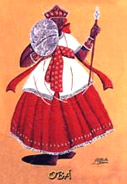
Is a valiant and strong warrior.
She is a feminine Orixá of incredible energy and stronger than many male Orixás.
Deity of the namesake river, she was Xangô’s third wife.
Obá’s dance is one of a warrior: ela she takes a sabre in one arm and the shield on the other.
The arquetype is of women of great value.
|
|
|
YEWA
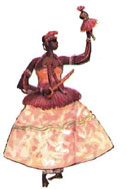
Is another female Orixá, linked to beauty, to dawn and to mother witches.
In Brasil, this Deity carries a good dose of femininity.
Some houses say she is the feminine part of Oxumaré, being then a female snake.
Salutes
– Hi, Ho !
|
|
|
YEMANJÁ

Represents the waters of the oceans and all its fertility, the source of life in remote times. She’s one of the most ancient Orixás of the waters, occupying next to Oxalá, in mythology, a high hierarchical position. She is called Sabá – Queen of the Ocean. Individuals are rational and organized, in terms of social representation in the group,. They are characterized by intense intellectual production .Writers, artists, psychologists and sociologists are some of their diverse professional activities.
Salutes
– Odoyá, Yemanja!
|
|
|
IYA MI
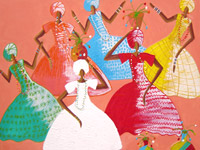
They are the great mothers (of remote times), with deep connections with the earth and the destiny of human beings. They are the genitors of most of the AXÉ (vital power) that we carry, and indisputably connected to our protection against angry attacks of negative energies emanated by other human beings.
They are important in the accepting and softening the negative events that are traced in the individual’s destiny; the acceptance comes after the knowledge of the ODU (revealed through Ifá… called destiny) de cada umof each one and the softening comes in the sense that they’ll manage to overcome these obstacles. These contribute to our strengthening. She is a presence that leaves its mark in the visible and invisible world, guiding the good energy exchanges between human beings.
|
|
|
OXALÁ
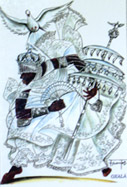
He is the father of all Orixás, and is also known by 16 other names : Babá, Orixalá, Obatalã, Oxalufã, Oxaguiã and others. Its syncretism is Jesus Christ for his high virtues, for his wisdom and infinite goodness. Symbolically, he represents the master, tutor and all men. All around him has to be white, including adornments, symbolizing purity, serenity and untouchable characteristic. His syncretism in Bahia is Senhor de Bonfim. The sons of Oxalá have as main exterior attitude kindness. Calmness, common sense, and meditation are normal virtues observed in their behavior. They tend to judge in a pure manner without demonstrating condescendence. They have standard attitudes in universal precepts. They are great teachers and collect respect and admiration without imposing values, or highlighting their notable personal qualities.
Saudação
– Xeu Eu Baba ou Epa Baba
|
|
|
|



















